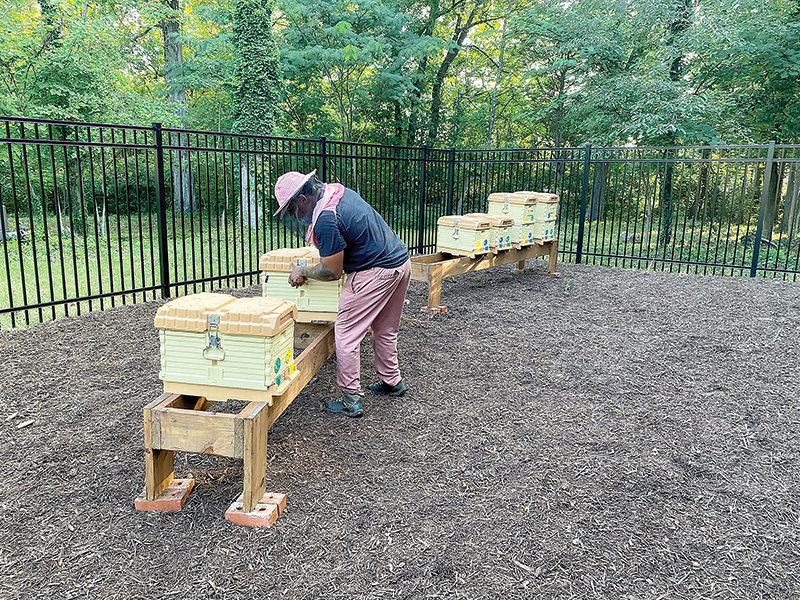 Charlotte beekeeper Jesse Holland removed a huge colony of honeybees from a wall in a building at St. Matthew Parish, then moved them into hives elsewhere on the parish campus. St. Matthew parishioners had the opportunity to learn about honeybees and honey production at a recent parish event. The parish hopes to bottle the honey next year and sell it to raise funds for ministries that feed the hungry.CHARLOTTE — St. Matthew parishioners are buzzing about a huge colony of honeybees that recently caused a stir on the parish campus.
Charlotte beekeeper Jesse Holland removed a huge colony of honeybees from a wall in a building at St. Matthew Parish, then moved them into hives elsewhere on the parish campus. St. Matthew parishioners had the opportunity to learn about honeybees and honey production at a recent parish event. The parish hopes to bottle the honey next year and sell it to raise funds for ministries that feed the hungry.CHARLOTTE — St. Matthew parishioners are buzzing about a huge colony of honeybees that recently caused a stir on the parish campus.
The bees were discovered in a massive hive – 5 feet by 7 feet – inside a wall of the parish’s New Life Center, as workers were attempting to install a new roof. After a few bee stings, they suspended work to make a plan to remove the hive.
Because honeybees are pollinators vital to the environment, parish leaders wanted to protect them. So they came up with a rescue plan that also would do good for the community.
The plan called for relocating the bees elsewhere on the church’s property and harvesting the honey for sale, with proceeds going to feed the hungry.
One of the roofers knew a local beekeeper. And soon Jesse Holland, owner of Charlotte-based Bizzy Bee Honey, Hives and More, stepped in to rescue the estimated 100,000 bees in the colony.
A hive that size was not built in a day, Holland said.
“There had probably been bees in there for a decade or close to it,” Holland said. “It’s likely the original colony died out and then others moved in. This usually happens in the spring when colonies are reproducing. They’ll go and find a space – usually a void in a tree. But if they find one like this that’s already got beeswax in it, it’s like moving into a furnished apartment.”
Holland used smoke to calm – but not harm – the bees, and then a special “bee vacuum” to safely remove the bees. He prepared the hive for transport to a bee yard on his property, where the bees could adjust before he returned them to the church campus.
First, he had to extract the honeycomb of the hive and cut it into slabs, each of which were placed into frames and placed into separate hives. The bees, undisturbed by the change of quarters, went right back to their original work of turning pollen into honey.
Meanwhile, St. Matthew found a new home for the bee colony on undisturbed land along Elm Lane and erected a tall black metal fence to keep out predators. In early September, Holland moved the bees into 10 “apiaries” or bee boxes that hold multiple beehives.
The bees are free to come and go, and they’ll forage on flowering plants in the area and produce wildflower honey. Holland will visit the hives every two to three weeks to make sure the bees are healthy and happy.
“We’re going to harvest the honey once a year, most likely in July, and it will be bottled and sold to go toward our hunger-relief ministry,” said Antoinette Usher, chief operating officer for St. Matthew.
And to have a little fun, St. Matthew introduced a contest in which parishioners can submit suggested names for the parish’s soon-to-be signature brand of honey. Parishioners are buzzing with creativity and will vote on their favorite name later this year. One contender: “Glory Bee!”
— Christina Lee Knauss. Photos by Troy Hull and St. Matthew Parish
More online
At www.stmatthewcatholic.org/honeybees: See more photos and videos of St. Matthew Church’s honeybees and their new home
Honey from the bees at St. Matthew will be collected and sold in jars under a name still to be determined, with proceeds going to ministries that help hungry people.













